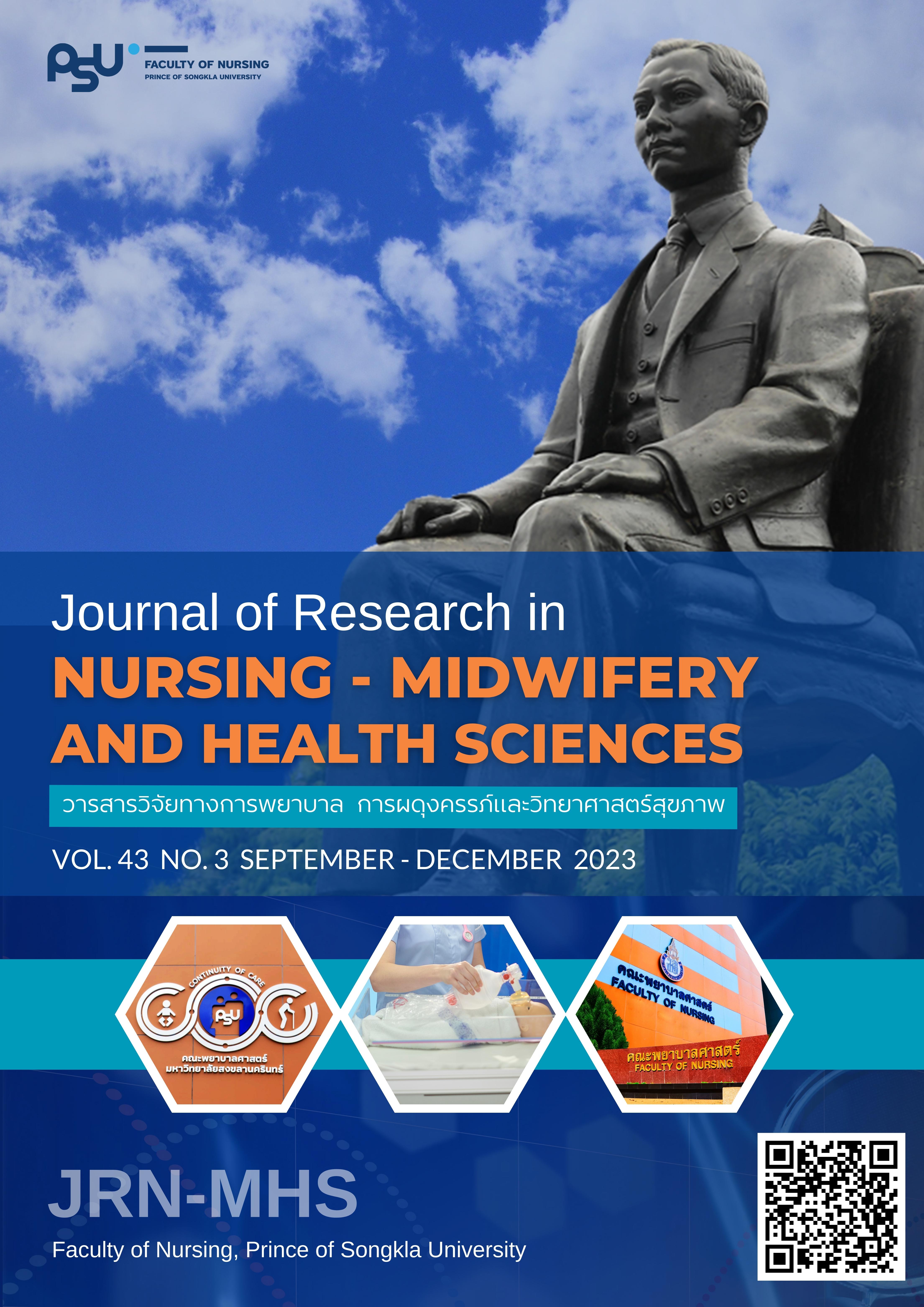การพัฒนาโปรแกรมส่งเสริมความสามารถของผู้ดูแลรุ่นปู่ย่าตายายในการจัดกิจกรรมการเล่นเพื่อส่งเสริมพัฒนาการด้านกล้ามเนื้อมัดเล็กและสติปัญญาในเด็กวัยก่อนเรียน
Main Article Content
บทคัดย่อ
วัตถุประสงค์: การวิจัยและพัฒนามีวัตถุประสงค์เพื่อพัฒนาและทดสอบความเป็นไปได้ของโปรแกรมส่งเสริมความสามารถของผู้ดูแลรุ่นปู่ย่าตายายในการจัดกิจกรรมการเล่นเพื่อส่งเสริมพัฒนาการด้านกล้ามเนื้อมัดเล็กและสติปัญญาในเด็กวัยก่อนเรียน วิธีการ: ระยะที่ 1) การพัฒนาโปรแกรม และระยะที่ 2) การประเมินความเป็นไปได้กลุ่มตัวอย่าง คือ ผู้ดูแลรุ่นปู่ย่าตายาย จำนวน 6 คน คัดเลือกแบบเจาะจง เครื่องมือในการวิจัยประกอบด้วย 1) แผนการส่งเสริมความสามารถในการจัดกิจกรรมการเล่นเพื่อส่งเสริมพัฒนาการด้านกล้ามเนื้อมัดเล็กและสติปัญญา 2) แบบสอบถามความสามารถในการส่งเสริมพัฒนาการของผู้ดูแลครอบครัวข้ามรุ่น มีค่าดัชนีความตรงเชิงเนื้อหา (content validity index: CVI) = .92 และ และมีค่าความเที่ยง เท่ากับ .94 และ 3) แบบประเมินพัฒนาการด้านกล้ามเนื้อมัดเล็กและสติปัญญาของเด็กวัยก่อนเรียนมีค่าความเที่ยงเท่ากับ .95วิเคราะห์ข้อมูลโดยใช้สถิติเชิงพรรณนา ผลการศึกษา: ระยะที่ 1 พบว่า โปรแกรมที่พัฒนาขึ้น ประกอบด้วย 4 ขั้นตอน คือ 1) การประเมินความสามารถ 2) การให้ความรู้ การชี้แนะ การสนับสนุนและสร้างสิ่งแวดล้อม 3) การติดตาม และ 4) การประเมินผลโปรแกรมมีค่าดัชนีความตรงเชิงเนื้อหา (CVI) = 1 และผลการศึกษาระยะที่ 2 พบว่า กลุ่มตัวอย่างมีคะแนนความสามารถในการส่งเสริมพัฒนาการมากกว่าก่อนการทดลอง (MD = 87, IQR = 4) และเด็กมีพัฒนาการด้านกล้ามเนื้อมัดเล็กและสติปัญญาดีกว่าก่อนการทดลอง สรุป: โปรแกรมมีความตรงเชิงเนื้อหา และมีความเป็นไปได้ในการนำไปใช้ในผู้ดูแลรุ่นปู่ย่าตายาย เพื่อกระตุ้นพัฒนาการด้านกล้ามเนื้อมัดเล็กและสติปัญญาในเด็กวัยก่อนเรียน
Article Details

อนุญาตภายใต้เงื่อนไข Creative Commons Attribution-NonCommercial-NoDerivatives 4.0 International License.
เอกสารอ้างอิง
National Institute of Child Health Development, Department of Health, Ministry of Public Health. The results of the analysis of early childhood development data [Internet]. Nonthaburi: National Institute of Child Health Development; 2022 [cited 2022 Aug 30]. Available from: https://nich.anamai.moph.go.th/th/kpr66/download?id=105559&mid=37540&mkey=m_document&lang=th&did=32022
Saithong A, Suksawat J, Sabaiying W. The effects of using an integrated guidance activities package to enhance child development enhancing behaviors of parents whose children are suspected to have delayed development at Tessaban 2 (Wat Payang) School in Chiang Rai province. phdssj. 2019; 9(3): 789-802. doi: 10.14456/phdssj.2019.56. Thai.
Equitable Education Fund. The latest survey results from the Department of Health Consistent with the research findings of the Office of Education, found that 1 in 4 preschool children had delayed development. Pointing out important questions for the new semester 2/2022 [Internet]. Bangkok: Equitable Education Fund; 2022 [cited 2022 Nov 1]. Available from: https://www.eef.or.th/news-tsqp-011122
Siriwannabut P. Developmental psychology. Bangkok: Chulalongkorn University Printing House; 2018. Thai.
Krachapngoen W. The learning experiences by using creative art activity sets with low relief to develop small muscles for early childhood in 1st kindergarten. JETC. 2019; 2(6): 171-80. Thai.
Manorat S, Palinthorn N, Koonmee J, et al. Promoting fine-motor development of preschool children by using creative arts activities [Internet]. Saraburi: Regional Health Promotion Center 4 2017 [cited 2020 Feb 8]. Available from: http://203.157.71.115/knowledge/mapping/paper/view?id=275
Wittayalapa K, Namwong S, Suknawatpong T, et al. Development of fine motor by using activities Making Thai desserts for kindergarten grade 1 children [master’s thesis]. [Bangkok]: Suan Dusit Rajabhat University; 2016. 47 p.
Pakinamhang T, Nakhunsong T, Ekapim S. Basic mathematic skill development of early childhood student by using creative art activities out of classroom. Sripatum Chonburi Journal. 2015; 12(2): 171-81. Thai.
Wongmanee A. The effects of molding activities on fine motor skills of preschool children. Sripatum Chonburi Journal. 2012; 8(4): 94-100. Thai.
Potipatsa G. Child development promotion through local wisdom practice. SKHJ. 2019; 22(3): 115-28. Thai.
Klinnuay T, Thanachaikan N, Panyapruk S. The development of 2nd grade-preschool students’ Thai writing skills through using Montessori approach-based instructional visual aids in Anubarn Wiangchai School, Office of Chiangrai Primary Educational Services Area 1. crru.grad.sch.j. 2017; 10(2): 61-72. Thai.
Tongnamang B. The effects of creative activities on the writing readiness and cooperative behaviors of the second year preschoolers at learning home international kindergarten, Yannawa region, Bangkok. Veridian E-Journal, Silpakorn University (Humanities, Social Sciences and arts). 2012; 5(3): 371-80. Thai.
Kadar M, Yunus FW, Tan E, et al. A systematic review of occupational therapy intervention for handwriting skills in 4-6 year old children. Aust Occup Ther J. 2020; 67: 3-12. doi: 10.1111/1440-1630.12626.
Strooband KFB, Rosnay M, Okely AD, et al. Systematic review and meta-analyses: Motor skill interventions to improve fine motor development in children aged birth to 6 years. J Dev Behav Pediatr. 2020; 41(4): 319-31. doi: 10.1097/DBP.0000000000000779.
Chumai T. Growth and development of early childhood. HHSK. 2016; 1(2): 18-33. Thai.
Thatansin S. The situation of children and natural deficiency disorders: Children and aging society in a changing state [Internet]. Nonthaburi: Department of Mental Health; 2021 [cited 2021 Jun 28]. Available from: https://dmh.go.th/news-dmh/view.asp?id=30894
Jampaklay A, Tangchonlatip K, Richter K, et al. Effects of internal migration on well-being and early childhood development: Results of a quantitative and qualitative baseline survey. Institute for Population and Social Research Mahidol University; 2016. Thai.
Losatiankit P, Kangkan W, Pupongpunkol K, et al. Situation of Thai childhood development in 2014. JHS. 2017; 26(Suppl2): 199-208. Thai.
Potipatsa G, Muenthaisong S, Raknatee D, et al. Childhood parenting by grandparents in a skipped-qeneration family, SKHJ. 2020: 2(3): 182-91. Thai.
Hengboonyaphan D. Playground: Playful things that must be serious [Internet]. Bangkok: The Momentum team; 2019 [cited 2019 May 10]. Available from: https://themomentum.co/thai-health-playground-advertorial
Siriwong P, Kaewthip N. The conditions and the adjustment guidelines of elderly people who have raised their grandchildren of generation-z Khok Samrong, Changwat Lopburi [Internet]. Rattanakosin RMUTR; 2017 [cited 2019 May 10]. Available from: http://repository.rmutr.ac.th/123456789/799
Berbiglia VA, Banfield B. Self-care deficit theory of nursing. In: Alligood MR, editor. Nursing theorists and their work. Elsevier; 2018.
Orem DE. Nursing: Concepts of practice. New York: McGraw-Hill; 1985.
National Institute of Child Health Development, Department of Health, Ministry of Public Health. Developmental surveillance and promotion manual (DSPM). Nonthaburi: Veterans Welfare Organization Printing Office; 2020. Thai.
Joanna Briggs Institute. JBI levels of evidence [Internet]. Australia: Joanna Briggs Institute; 2013 [cited 2023 Oct 15]. Available from: https://jbi.global/sites/default/files/2019-05/JBI-Levels-of-evidence_2014_0.pdf
Polmark J, Deoisres W, Chaimongkol N. The effects of grandmother language intervention on grandmothers’ knowledge and language development of toddlers. TPHSJ. 2021; 16(1): 30-7. Thai.
Milovanska-Farrington, S. The effects of parental and grandparental supervision time investment on children’s early age development. Research in Economics. 2021; 75(3): 286-304. doi: 10.1016/j.rie.2021.06.006.
Sirithongthawan S. The development of developmental surveillance and promotion manual: DSPM. J Psychiatr Assoc Thailand. 2018; 63(1): 3-12. Thai.
Boonjeam S, Thongthai T, Puriso P. The early childhood developmental surveillance and promotion manual for grandparents. JHEALTH. 2021; 44(2): 97-1. Thai.
Nahuanil C. The development of fine motor muscle of early childhood student by implementing creating molding activities. JSI. 2019; 16 (2): 484-97. Thai.
Hammond SL, Witherspoon RL, Day B. Good school for young children: A guide for working with three-, four, and five-year-old children. New York: Macmillan; 1984.


